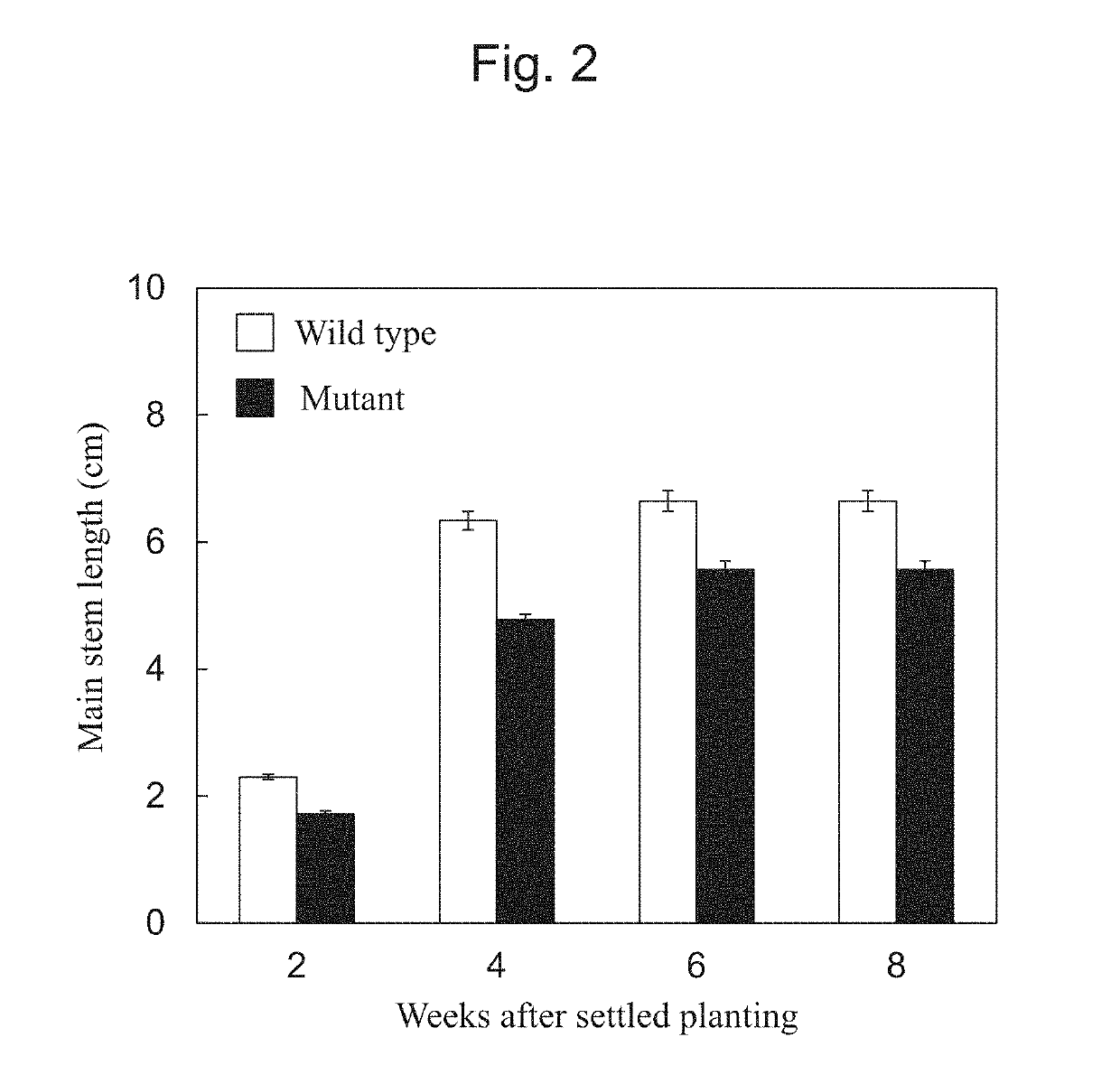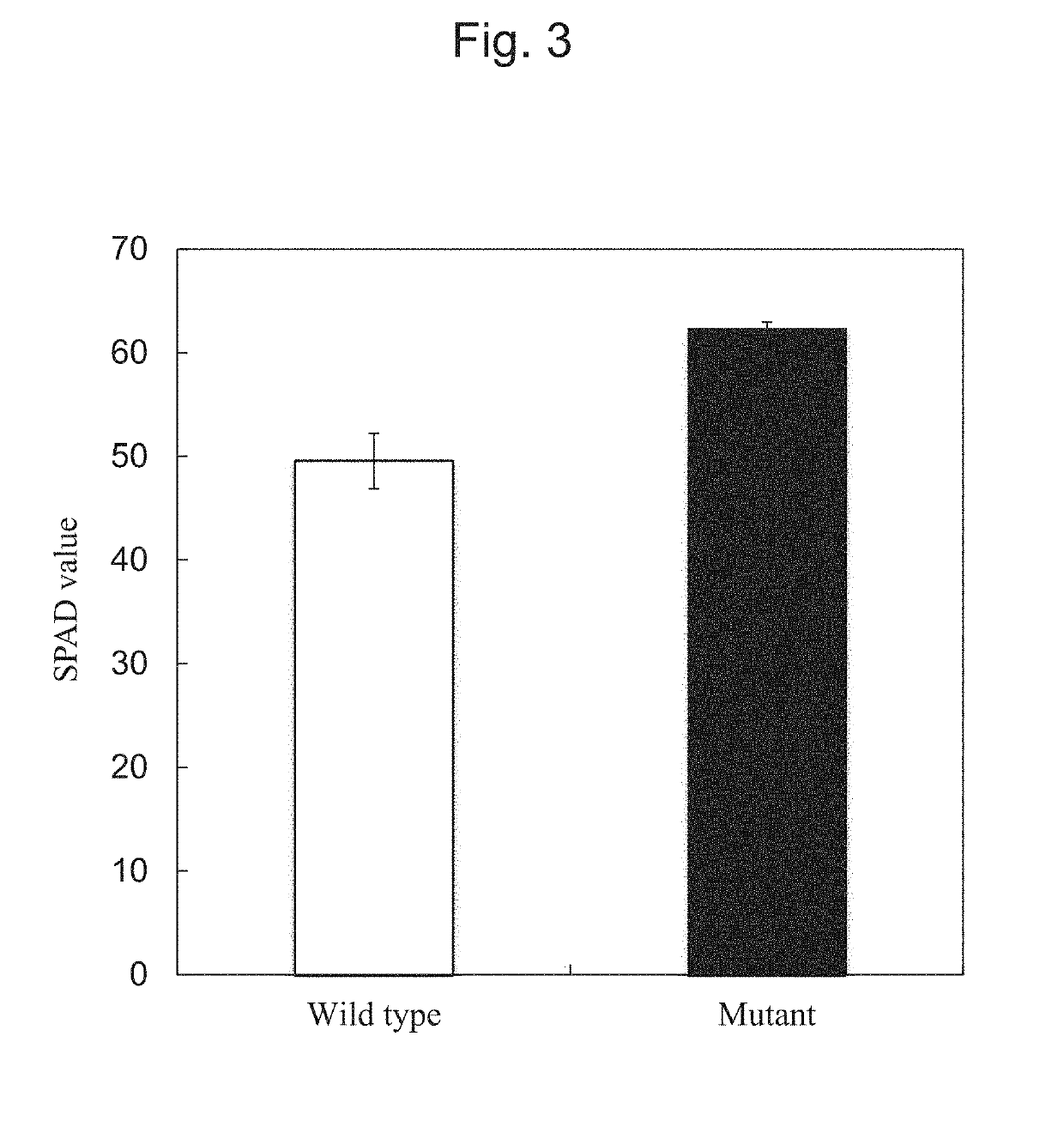Plant having mutant cyclin f-box gene
a plant and cyclin technology, applied in the field of plants having a mutant cyclin fbox gene, can solve the problems of significant decrease in labor efficiency, economic efficiency, labor efficiency and stability, and reduce the pollination and fruit-setting rate, so as to facilitate the production of plants with parthenocarpy and improve the sugar content of fruits
- Summary
- Abstract
- Description
- Claims
- Application Information
AI Technical Summary
Benefits of technology
Problems solved by technology
Method used
Image
Examples
example 1
[Example 1] Production of Tomato Mutant Strains and Selection of Parthenocarpic Tomato Strains
[0130]EMS treatment (EMS mutagenesis treatment) was conducted by allowing 3000 seeds of the wild type tomato variety Micro-Tom (Solanum lycopersicum cv. Micro-Tom) to absorb sterile water at room temperature for 4 hours and then soaking the seeds in 100 ml of 1.0% ethyl methanesulfonate (EMS) solution with stirring for 16 hours. The seeds were taken out from the EMS solution and washed with 100 ml of sterile water for 4 hours with stirring. This washing process was repeated 3 times. Then, the seeds were allowed to germinate on filter paper moistened with sterile water and cultivated in a glass greenhouse. M2 seeds were formed by self-pollination from each strain (M1 generation) and collected. Ten M2 seeds per strain were sown and cultivated in connected pots containing culture soil in a glass greenhouse. Thus, Micro EMS-mutagenized population of tomato plants was obtained. Individuals (stra...
example 2
[Example 2] Growth Characteristics of the Parthenocarpic Tomato Mutant Strain
[0134]Seeds of the parthenocarpic tomato mutant strain (E8986 strain) selected in Example 1 and the wild type tomato variety Micro-Tom (Solanum lycopersicum cv. Micro-Tom) (22 and 24 seeds, respectively) were used for comparing the strains in terms of growth characteristics. The significant difference between the obtained data of the treatment groups was tested with the Tukey-kramer HSD test.
[0135]The seeds were allowed to absorb sterile water for 3 days. The seeds after water absorption for 3 days were settled on Rockwool (mini block; size: 50 cm×50 cm×50 cm, Grodan) and cultivated in a plant factory at 25° C. with a day length of 16 hours until 8 weeks after settled planting. Irrigation was conducted by circulating a nutrient solution (Otsuka House A formulation) prepared from nutriculture fertilizers OAT House 1 and OAT House 2 at an electric conductivity (EC) of approximately 1.5 ms / cm once a day during...
example 3
[Example 3] Fruit Characteristics of the Parthenocarpic Tomato Mutant Strain
[0139]Plant individuals of the parthenocarpic tomato mutant strain (mutant) selected in Example 1 and the wild type tomato variety Micro-Tom (wild type) (13 and 10 individuals, respectively) were cultivated for comparing the strains in terms of fruit characteristics. The significant difference between the obtained data of the treatment groups was tested with the Tukey-kramer HSD test.
[0140]The wild type and mutant strains were subjected to pollination treatment after flowering, or emasculation treatment before flowering. Pollination treatment was conducted by vibrating flowers using a vibrator (vibration pollination). The number of fruits was restricted to two per flower truss, and excess fruits were removed. Fruits with entirely red pericarp (i.e., red ripe fruits) were collected and immediately examined for fruit characteristics. For examination of fruit characteristics, the fruit-setting rate / parthenocarp...
PUM
| Property | Measurement | Unit |
|---|---|---|
| length | aaaaa | aaaaa |
| length | aaaaa | aaaaa |
| length | aaaaa | aaaaa |
Abstract
Description
Claims
Application Information
 Login to View More
Login to View More - R&D
- Intellectual Property
- Life Sciences
- Materials
- Tech Scout
- Unparalleled Data Quality
- Higher Quality Content
- 60% Fewer Hallucinations
Browse by: Latest US Patents, China's latest patents, Technical Efficacy Thesaurus, Application Domain, Technology Topic, Popular Technical Reports.
© 2025 PatSnap. All rights reserved.Legal|Privacy policy|Modern Slavery Act Transparency Statement|Sitemap|About US| Contact US: help@patsnap.com



